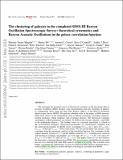The clustering of galaxies in the completed SDSS-III Baryon Oscillation Spectroscopic Survey : theoretical systematics and Baryon Acoustic Oscillations in the galaxy correlation function
Abstract
We investigate the potential sources of theoretical systematics in the anisotropic Baryon Acoustic Oscillation (BAO) distance scale measurements from the clustering of galaxies in configuration space using the final Data Release (DR12) of the Baryon Oscillation Spectroscopic Survey (BOSS). We perform a detailed study of the impact on BAO measurements from choices in the methodology such as fiducial cosmology, clustering estimators, random catalogues, fitting templates, and covariance matrices. The theoretical systematic uncertainties in BAO parameters are found to be 0.002 in the isotropic dilation α and 0.003 in the quadrupolar dilation ε. The leading source of systematic uncertainty is related to the reconstruction techniques. Theoretical uncertainties are sub-dominant compared with the statistical uncertainties for BOSS survey, accounting 0.2σstat for α and 0.25σstat for ε (σα, stat ∼ 0.010 and σε, stat ∼ 0.012, respectively). We also present BAO-only distance scale constraints from the anisotropic analysis of the correlation function. Our constraints on the angular diameter distance DA(z) and the Hubble parameter H(z), including both statistical and theoretical systematic uncertainties, are 1.5 per cent and 2.8 per cent at zeff = 0.38, 1.4 per cent and 2.4 per cent at zeff = 0.51, and 1.7 per cent and 2.6 per cent at zeff = 0.61. This paper is part of a set that analyses the final galaxy clustering data set from BOSS. The measurements and likelihoods presented here are cross-checked with other BAO analysis in Alam et al. The systematic error budget concerning the methodology on post-reconstruction BAO analysis presented here is used in Alam et al. to produce the final cosmological constraints from BOSS.
Citation
Vargas-Magaña , M , Ho , S , Cuesta , A J , O'Connell , R , Ross , A J , Eisenstein , D J , Percival , W J , Grieb , J N , Sánchez , A G , Tinker , J L , Tojeiro , R , Beutler , F , Chuang , C-H , Kitaura , F-S , Prada , F , Rodríguez-Torres , S A , Rossi , G , Seo , H-J , Brownstein , J R , Olmstead , M & Thomas , D 2018 , ' The clustering of galaxies in the completed SDSS-III Baryon Oscillation Spectroscopic Survey : theoretical systematics and Baryon Acoustic Oscillations in the galaxy correlation function ' , Monthly Notices of the Royal Astronomical Society , vol. 477 , no. 1 , pp. 1153-1188 . https://doi.org/10.1093/mnras/sty571
Publication
Monthly Notices of the Royal Astronomical Society
Status
Peer reviewed
ISSN
0035-8711Type
Journal article
Collections
Items in the St Andrews Research Repository are protected by copyright, with all rights reserved, unless otherwise indicated.

